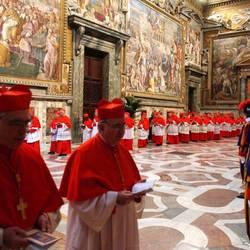Scola Betrayed by the Italians from the Very First Vote
By Giacomo Galeazzi
The tide was turned by old grudges and the bond with the CL movement Already on Tuesday it looked as though things could get complicated for the cardinals’ top favourite, Scola. A few moments after the extra omnes and the meditation in the Sistine Chapel, Bergoglio surprisingly and very suddenly obtained the largest number of votes. At the first ballot, however, the votes were too scattered for cardinals to get a truly indicative picture. Still, it was a warning sign to the Archbishop of Milan, who was credited with such chances of victory yesterday, that just minutes from the Proto-Deacon’s announcement, an unfortunate statement by the Secretary General of the Italian Bishops’ Conference (CEI) expressed "the feelings of the entire Italian Church in welcoming the news of the election of Cardinal Angelo Scola as the successor of Peter." Scola's path to the Holy Throne was blocked by the confluence of two alliances and of two distinctly different evaluation systems: the non-European one (South America in particular), on the one hand, planned on bringing the papacy out of the old continent for the first time. On the other hand, there was the Curia group led by the nemesis-allegiance of Bertone and Sodano, who are inexorably hostile to Scola. The reason, according to certain voices in the Holy See, are a series of "ancient envies and rivalries”. Bertone has never forgotten the advice that Scola gave to the Pope during a meeting in Castel Gandolfo during the upheaval over the pardon granted to Holocaust-denier Bishop Williamson: his replacement at the helm of the Secretariat of State. Sodano, on the other hand, found himself on opposing sides from Scola in various power struggles for the control of Catholic institutions. Ruini himself, while esteeming Scola, gave no indications to vote in his favour to the conclavists, like the Australian Pell, who asked to visit him before the Conclave. In short, the 28 Italian voters did not all row in the same direction and so they dashed their chances of installing one of their compatriots to Peter's Throne 35 years after Luciani. Not even among the residential Italian archbishops was there a complete consensus for Scola, and therefore the votes that many European voters cast in his favour no longer sufficed. Furthermore, the conclavists near the community of Sant'Egidio (Sepe, for example) could not look kindly upon Scola's involvement in a movement so different from theirs as the Communion and Liberation (CL) one. In the last few hours there were signs that Scola's strong candidacy was a giant with clay feet. In other words, everybody recognized his exceptional stature as a Bishop and intellectual, but then, digging a little deeper, beyond the circumstancial phrases, separations and reserves began to crop up. Most of all, the idea of an "overseas flight" became more prevalent, which was undermining the opportunity to fall back on a Italian pontificate, as most of the Church's growth is in South America, Africa, and Asia. "There cannot always be a shepherd upstream with a flock downstream", summarized an African cardinal in the congregation. Also, shortly before the start of the Conclave, the Sodano-supporter Lajolo had publicly voiced the Curia’s annoyance at the protagonism displayed by the American group, and few picked up on the Dean's party's approval for a more sober style. A low-key profile: the etiquette adopted by Bergoglio for the entire duration of the sede vacante period. Very little exposure, minimal public outings and appearances at the General Congregations like all the other peons of the College of Cardinals, even though, in the papal election of 2005, he had obtained more votes than anyone else except for Ratzinger. And Benedict XVI has never made any secret of his consideration for the austere Jesuit who has "cleansed" the Argentinian Church from its involvement with the military regime. For Bergoglio, now as eight years ago, the fatal place was Domus Sanctae Marthae; but this time with the opposite result. What happened yesterday at 13:30 in the Domus mattered more than the Sistine Chapel early result-less ballots. The black smoke episodes were followed by the domestic meetings in the residence of the voters. Bertone and Re spoke with Bergoglio guaranteeing their support. Earlier, the conclavists ate and slept in the chapel frescoed by Michelangelo, but, since 2005, it is customary for them to return (by shuttle or on foot) to the hotel renovated by John Paul II for their meals and overnight rest. During lunches and dinners, the cardinals discuss freely and the bridge-builders spring into action offering a possible reconciliation between the various factions. Eight years ago, it was in the refectory of Sanctae Marthae where the match ended in Ratzinger's favour. "From the Last Supper onwards, in the Church the important things are decided at the table", explained one of Ratzinger's electors with a smile. In the 2005 conclave, after the first three votes, Bergoglio addressed a speech to the diners destined to immediately change the fortunes of that Papal election. He explicitly asked his forty supporters to stop voting for him. In short, cardinals decided who was to dress in white and appear once again on the balcony of St. Peter’s, over a plate of pasta or a digestif. The hours spent in the Sanctae Marthae residence, between lounges, confessionals and the “in-house” Chapel, gave cardinals excellent opportunities to informally agree on the discarding of candidates with fewer votes, to give an advantage to the papabile who had received the most votes in the first three ballots.
|
.
Any original material on these pages is copyright © BishopAccountability.org 2004. Reproduce freely with attribution.
